Feature Deep Sea
The ocean is vast and largely unexplored, leading people to think of it as a mysterious place where action only occurs at the surface. However, the reality is that there’s another dimension that is crucial for the flora and fauna that brings the ocean to life: depth.
Most fish, plants, mammals, and other marine organisms live near the surface, while a smaller number of species are distributed towards the deeper depths, where there’s less sunlight. Thus, the same sea can host dramatically different species depending on its depth.
For example, fish near the surface can use their eyesight and striking colors to find a mate and hunt. The clear visibility near the surface also requires species to camouflage and hide from predators. Some use a technique known as countershading, like the blue glaucus (Glaucus atlanticus).
Fish in the dark depths must resort to different tactics. Deep-sea species use adaptations like self-generated light (bioluminescence), enhanced senses, enlarged eyes, and special colorations. For example, species that are red are virtually invisible to predators in the deep sea since red light cannot reach these depths.
To get a better idea of how depth influences ocean life, here are some species that inhabit the three major depth zones.
SUNLIGHT ZONE
Between 1 and 200 meters (660 feet)
Most marine life is concentrated in coastal areas and in the most superficial layers of the oceans where, thanks to the entry of sunlight, algae and marine plants can photosynthesize, generating vital support for the base of the food chain. These brighter marine places are known as the epipelagic zone, or sunlight zone. Some animals that inhabit this zone include:
Great white shark (Carcharodon carcharias)
This shark is one of the largest sharks in the world behind the whale shark and basking shark. Although it’s also suited for cold water, it prefers warmer temperate seas. Unlike most fish, it is a warm-blooded animal, which allows it to be a more active predator in cooler waters compared to cold-blooded species.
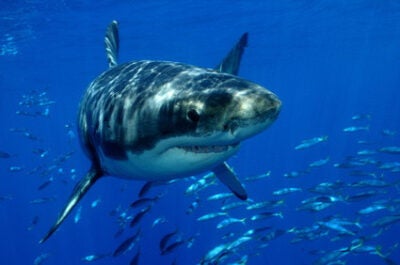
Red comb star (Astropecten aranciacus)
These echinoderms feed mainly on slow moving or sessile prey, including bivalves. Rather than using eyesight, they detect prey from waterborne odors by using chemosensory receptors. They are most commonly found in the subtidal zones of the Aegean and Mediterranean Sea.
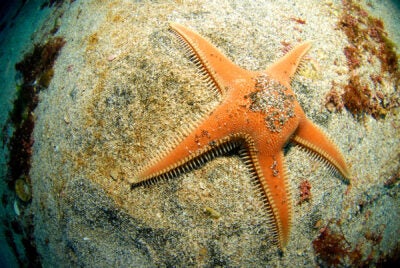
Loggerhead turtle (Caretta caretta )
This turtle’s paddle-shaped fins allow them to elegantly glide through the water. These sea turtles can remain underwater for several hours without having to surface to breathe. They migrate thousands of kilometers until they return to their nesting beaches to lay their eggs.
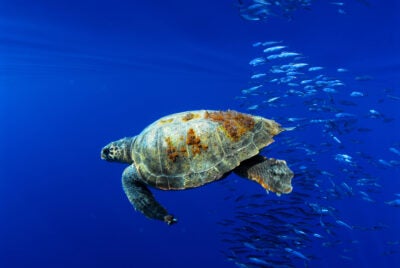
Spotted porcupinefish (Diodon hystrix)
To protect itself from its predators, this fish inflates itself like a balloon by swallowing water and straightening its spines. Its beaked mouth allows it to break the hard shell of mollusks and crustaceans. They are generally found in holes and crevices of coastal areas like lagoons, caves, shipwrecks, and reefs.
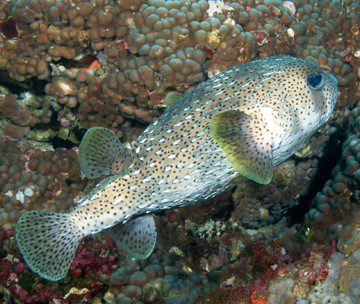
TWILIGHT ZONE
Between 200 and 1,000 meters (650 to 3,300 feet)
At greater depths the light becomes dimmer, creating what is known as the mesopelagic zone or twilight zone. With a lack of solar energy, animals in these places must develop other strategies to survive and adapt to the low light, increasing atmospheric pressure, and low temperatures. Marine life that can be found in the twilight zone include:
Sperm whale (Physeter macrocephalus)
These whales spend most of their time descending to depths of 2,000 feet to hunt for food. They are capable of diving to even deeper depths (over 10,000 feet) for over an hour. At these depths they feed on squid, sharks, skates, and fish.
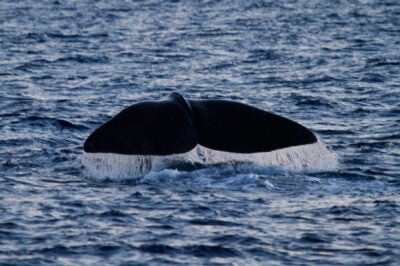
Common octopus (Octopus vulgaris)
All cephalopods, like these octopuses, have tentacles with suction cups. The octopus uses them to glide along the ocean floor, feel, touch, and capture its prey. It is one of the most intelligent marine animals, with the ability to modify its color and appearance to camouflage itself.
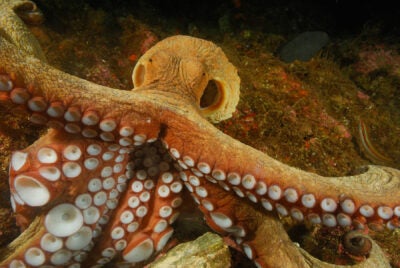
The mauve stinger (Pelagia noctiluca)
Like many types of jellyfish, the mauve stinger has long tentacles full of stingers that act as a defense mechanism and to capture their prey. The stingers cause severe hives6 if humans come into contact with them. 95% of their body is made up of water and they travel through the seas by letting themselves be carried by the currents.
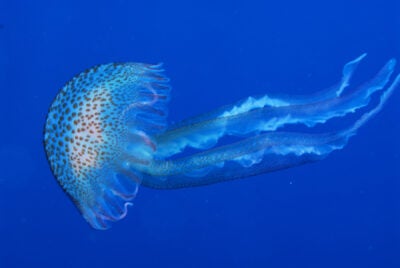
MIDNIGHT ZONE
Between 1,000 and 4,000 meters (3,300 – 13,100 feet)
The bathypelagic or midnight zone can reach depths of 4,000 meters (13,100 feet). Organisms in this zone live in complete darkness. Many creatures have developed adaptations to generate their own light, called bioluminescence, to attract prey or to find a mate. Some species have lost their ability to see anything at all.
There are more than 200 species of deep-sea anglerfish. The diverse range of anglerfish species in the deep-sea have adapted with features including male dwarfism, bioluminescent lures to capture prey, and unique reproductive modes like male sexual parasitism – where males attach to the female deep-sea anglerfish as their mating strategy.
Sloane’s viperfish (Chauliodus sloani)
These fish are mainly found at depths ranging from 200 to 1,000 meters (656 to 3,280 feet). Their light-producing organs called photophores along their belly mask the fish’s silhouette from predators below and can be used to attract prey. Their jaw is so large that it must dislocate it to swallow its prey and its first vertebra has evolved to act as a shock absorber for their powerful bite.
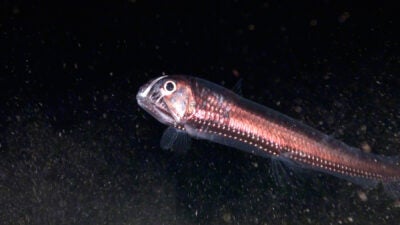
Pelican eel (Eurypharynx pelecanoides)
This strange eel-like fish engulfs its prey with its huge mouth. It can expand its throat and stomach to swallow large fish and crustaceans. They have many, many teeth in their jaw and the end of their tail flashes pink or red through bioluminescence.
ABYSSAL ZONE
4,000 – 6,000 meters (13,000 – 20,000 feet)
In the abyssal plains, unique forms of life develop. Animals that live in this deep-sea zone include basket stars, seapigs, and seaspiders. Some crustaceans living at these depths have evolved without eyes, since they must rely on other senses to survive due to the absence of sunlight. Species can survive thanks to the “rain” of organisms and organic matter that sink from the most superficial layers.
Additionally, there are bacteria that, due to the lack of sunlight, carry out chemosynthesis (they obtain energy from chemical substances). The species found here live in icy-cold waters, with atmospheric pressure that would crush most animals on the planet – including humans.
Deeper is the hadal or hadopelagic zone, with depths of up to 6,000 meters (20,000 feet), which are generally ocean trenches.
The deepest known place in the ocean measures 10,935 meters (35,876 feet), which is found in the Pacific Ocean’s Mariana Trench, also known as “Challenger Deep”. The challenging, merciless environment of the ocean depths makes scientific exploration extremely difficult.
Learn more: Living in the deep sea https://europe.oceana.org/blog/living-in-the-deep-sea/

